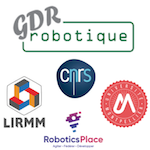|
|
ATTENTION : Service interruption on Monday 11 July from 12:30 to 13:00
all the CCSD's websites (Sciencesconf, HAL, Episciences, AureHAL) will be inaccessible (network hardware connection). |
|
|
RESUME Le contexte industriel (usine du futur, FoF) n'a jamais été aussi favorable qu'aujourd'hui au déploiement de robots collaboratifs. Il est prévu en effet, que les PME, jusqu'à présent réticentes à l'adoption de robots, principalement à cause de leur rigidité, se tourneront vers ce marché, dès lors que la robotique saura proposer des solutions flexibles pour des contextes de production divers. C'est le bilan d'une enquête menée récemment par Loupventures, qui estime que d'ici 2025 un robot sur trois sera de type collaboratif. L'enquête estime aussi que, tout comme pour l'essor de la robotique traditionnelle dans les années 70, l'industrie automobile sera la première à adopter ce type de solutions technologiques. Dès que l'on fait référence à la robotique collaborative, on ne peut pas ignorer l'interaction physique. Une des ambitions du GDR Robotique est d’inclure explicitement cette thématique dans le périmètre du Groupe de Travail GT5 Interactions Personnes / Systèmes Robotiques. L'interaction physique est fondamentale non seulement dans le cadre industriel (robotique collaboraive), mais aussi dans les applications de robotique d'assistance, robotique de service et robotique médicale. L'objectif de cette journée est de réunir tous les acteurs interessés par ce thème: chercheurs, industriels, enseignants et étudiants du supérieur. PROGRAMME 09:15-09:30 Andrea Cherubini, LIRMM, Montpellier - "Ouverture de la journée" 09:30-10:10 Ganesh Gowrishankar, LIRMM, Montpellier - "A Turing test of physical interaction: from neuroscience to robot control" 10:10-10:50 Ajay Pandey, QUT, Brisbane - "Design of soft and self-powered novel tactile sensors based on organic optoelectronics platform"
Robotic and medical applications are two of the main drivers behind the demand for the conformal and robust tactile sensing technologies such as electronic skins. In robotics, it is widely accepted that assigning the sense of touch would remove uncertainties in dealing with soft and deformable objects that are hard to model in dynamic and unstructured environments. In medicine, restoring sensory feedback to patients with skin damage, amputations or peripheral neuropathy could significantly improve their overall quality of life. Smart electronic skins are an emerging technology in conferring artificial sense of touch in robotics. However, assigning the human like distributed sense of touch over a large area has been challenging to replicate in modern medical, social and industrial robots. In this talk, we will present a new class of soft tactile sensors that exploit light as a vector technology and the advanced optical mechanisms of singlet fission in conjugated organic semiconductors [1]. We will show how a soft and compact optoelectronic array can accurately measure pressure, position and surface deformation applied to an elastomeric layer. 10:50-11:10 Coffee Break
11:10-11:50 Lorenzo Natale, IIT, Genês - "Vision and touch on the iCub robot: from object recognition to human-robot collaboration" 11:50-12:30 Jean-François Thibault, SAFRAN, France - "Le développement de la robotique collaborative dans le groupe Safran" 12:30-13:30 Lunch break 13:30-14:20 Visit of the LIRMM Robotics Lab 14:20-15:00 Antonio Franchi, LAAS, Toulouse - "Physical Interaction with Aerial Robots" 15:00-15:40 Bernard Bayle, ICUBE, Strasbourg - "Physical Human Robot Interaction in robot-assisted medical and surgical therapies" 15:40-16:00 Coffee Break 16:00-16:40 Ludovic Saint-Bauzel, Sorbonne Université, Paris - "Kinesthesic decision in physical Human Robot Interaction: first results in ISIR"
16:40-17:00 Andrea Cherubini, LIRMM, Montpellier - "Cloture de la journée" LOCALISATION La journée se déroulera dans la salle 2/022 du bâtiment 5 du LIRMM. |


